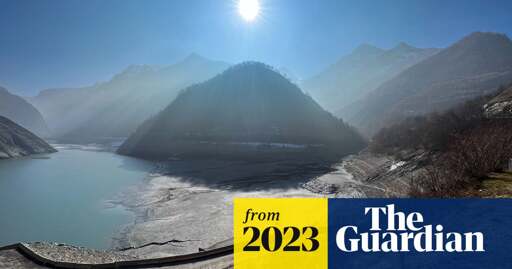Nestle: Just as planned
edit: On the bright side, Solar Stills will probably work a lot faster in the future.
I know you are joking, but for people that don’t know: Solar Stills are total scams. They might work in a pinch as a survival tool, but for long term it’s a non starter.
They have many issues, for example in places that don’t have a lot of water and thus would be the most needed, they simply don’t work. If there isn’t a lot of water in the air, there isn’t any to extract. Even in perfect conditions these things produce very little water, in most conditions you’d be lucky to get a couple of drops. Second issue is the water isn’t clean, there is so much stuff floating in the air, you can’t drink the water that comes out without filtering / boiling first. If that step is required you might as well go with ground or surface water sources. And if there isn’t any ground or surface water sources, there won’t be any water in the air most likely. Third issue is you are creating a hot and humid environment, which is an excellent breeding ground for all sorts of nasties. Think legionnaires disease and all sort of other bacteria and fungi. Within days it becomes a serious health hazard. Last issue is the materials used are almost by definition cheap and exposed to hard uv a lot of the time. This makes them degrade quickly and fall apart. Leaving plastic waste and chemicals leaking into the water it produces, until it just falls apart.
There have been so many crowd funding campaigns for clean water from the air over the past decades. Maybe some of them are simply naive and well meaning, but almost all are plain old scams. Feeding off the desire of people to help other people, only to fill their own pockets.
And furthermore, the problem with access to clean water is capitalism. There is plenty of water available, we have the means to extract it from the ground, surface and sea. We can process it, clean it, recycle it. Use trucks or pipes to transport it to places that don’t have it. The only issue is, that costs money and the people living where the water is needed don’t have a lot of money. So bringing water to these places simply doesn’t generate a profit and thus doesn’t get done. It isn’t some kind of huge technical issue, there are many rich places in the desert that have plenty of water. Think oil states in the Middle East, or places in the US like Nevada, Arizona, New Mexico etc. Capitalism is the issue, not technology.
America would rather invade Canada for water than tell private corporations they need to be regulated more.
The Guardian also has an excellent article today on companies like Nestlé and Danone emptying out aquifers.
‘It’s not drought - it’s looting’: the Spanish villages where people are forced to buy back their own drinking water | Life and style | The Guardian - https://www.theguardian.com/lifeandstyle/2024/nov/23/spanish-villages-people-forced-to-buy-back-own-drinking-water-drought-flood
40% huh? Where have I heard that percentage before…
Capital will literally destroy this planet in order to “profit” from cars and carnism.
Well, yes, but many regions that are going to have water supply issues aren’t near the animal ag farms. Closing a dairy farm in New Hampshire isn’t going to help things in central Africa. The bigger culprit is Climate Change bringing dry air flows to areas that previously had more humidity and precipitation.
Closing a dairy farm does actually help. It means less CO2 in the air, less climate change, and thus less dry air in central Africa.
For the water itself you are correct, but animal farms are very much a reason of climate change.
Well, and people will keep buying said things. Billionaires shouldn’t exist, and they’re easy to blame, but there’s not that many of them. They definitely aren’t personally eating that much meat, at least.
unsurprisingly, this “research” is also infected by poore-nemecek 2018
To clarify what this user is referring to, Poore & Nemecek 2018 is a recent, widely cited meta-analysis covering over 1530 studies assessing the environmental impacts of food. It’s published in one of the world’s top academic journals – Science – and authored by Dr. Joseph Poore, the director of the University of Oxford’s food sustainability program, and Dr. Tomas Nemecek, an expert on agroecology and life cycle assessments from the Zurich University of Applied Sciences.
They somehow constantly appear like a spectre whenever this study gets brought up to try to spread FUD about it through vague and unsubstantiated nonsense. They do this because it’s extremely compelling, effectively unambiguous evidence that many animal products such as dairy are abysmal for the climate (“because it’s devastating to my case!”). I highly encourage anyone interested to read it for themselves. The article is paywalled, but Dr. Poore hosts it for free through their personal website, so you don’t have to take either of our words for it.
Edit: the paper they quote (but conspicuously don’t link to) below to try to refute this methodology is itself a meta-analysis of 369 LCA studies in the same vein as Poore & Nemecek. I can’t; my sides are in orbit. Edit 2: For anyone wanting to read it in full, Lancaster University hosts Clune, Crossin & Verghese 2015 legally and for free as well, so again, you don’t have to take either of our words for it.
First, it is often cited that LCA results should not be compared (Desjardins et al., 2012; Foster et al., 2006; McAuliffe et al., 2016; Röös et al., 2013) due to variation in methodology choices, functional units, as well as temporal and regional differences2. Second, no single comprehensive review was identified that adequately covers the breadth of fresh foods available to consumers and caterers. As Helle et al. (2013, p.12643) state ‘data availability and quality remain primary obstacles in diet-level environmental impact assessment’, while Pulkkinen et al. (2015) calls for the creation of a database that communicates data quality, uncertainty and variability to reliably differentiate between the GWP of food types. Previous studies have compiled LCA data to compare different foods (e.g. Audsley et al., 2009; Berners-Lee et al., 2012; Bradbear and Friel, 2011; de Vries and de Boer, 2010; Foster et al., 2006; Nijdam et al., 2012; Sonesson et al., 2010; Roy et al., 2009). While these are useful attempts, the identified studies are inadequate in the coverage of fresh foods available. Environmental Product Declarations (EPDs) attempt to inform consumers of the environmental impacts (carbon, water and ecological footprint) of specific foods, however they also fall short in breadth of items covered at present. The most comprehensive attempt at carbon footprint labelling was performed by Tesco (2012), however failed to label key categories such as fresh fish, pork, lamb or beef before finishing in 2012 due to the scale of the labelling scheme and a lack of participation from other retailers (Head et al., 2013). Third, studies that do compare results may often present singular figures. Peters et al. (2010) and Röös et al. (2011) argue that a range of impacts should be reported from LCA’s to better represent the variety of environmental impacts, as opposed to a singular figure. Finally, there is a lack of synthesised open access LCA data in the public domain available to consumers to inform decision-making.
It’s exceptionally funny to me that you didn’t link to the study you’re quoting, because if you did, people would find out that you’re quoting a systematic review & meta-analysis of 369 LCA studies in the same vein as Poore & Nemecek 2018 did with 1530 LCA studies.
The ENTIRE POINT of the study you just quoted was that “there is a lack of synthesised open access LCA data in the public domain available to consumers to inform decision-making. Therefore this paper presents a systematic literature review and meta-analysis of food LCA studies in the last 15 years to assess the GWP of fresh food.” Thus, they appropriately synthesized the data using a meta-analysis. You’ve literally just disproven your own point. I hope you don’t actually believe that people reading this comment will fall for this.
I’m not trying to taunt you, rather I’m being completely serious: did you read the study you just linked beyond what you quoted?
they were honest enough to acknowledge that these studies varied so widely in methodology that combining them would be bad science, but went on to do it anyway. poore-nemecek doesn’t even acknowledge their faux pas.
That’s your characterization here? That’s the level of bad faith you’re acting on? That they spent an entire paragraph right upfront citing other papers talking about potential pitfalls for the express purpose of intentionally implicating themselves before doing it? Are you high? Or just deeply scientifically illiterate?
The entire point of that paragraph is to show that there are pitfalls if taking a naïve approach, but that an appropriately thought-out meta-analysis can meaningfully synthesize LCAs into one set of data, which they go on to explain in their ‘Methodology’.
your personal attacks are inappropriate.
your accusation of bad faith is, itself, bad faith
that doesn’t make their methodology any good.
it is not compelling, because the LCA references explicitly say that they cannot be combined with other LCA studies. poore-nemecek ignores this guidance and draws hyperbolic conclusions.
This is the FUD I was referring to. I’ve asked you before to point to even a single paper responding to this extremely high-profile meta-analysis with something even resembling this vague concern; you haven’t been able to turn one up. This should be trivial, because an LCA is an ISO standard, and thus failure to comply with it would be unambiguous for the hundreds if not thousands of scientists familiar with LCAs who have surely read and even cited this paper. I’ve even pointed out that the animal agriculture industry would be champing at the bit to refute a paper like this and has millions of dollars and teams of scientists to throw at the problem. But you can’t, because one doesn’t exist.
Your entire argument boils down to “Um, actually, meta-analyses are bad science”, which is completely hilarious. Hell, assuming Poore & Nemecek, the peer reviewers, and the entire scientific community ignored this alleged basic oversight, I’ve pointed out to you multiple times that you yourself could author a paper rebutting this and get it published if what you’re saying is even remotely credible. But it isn’t. Because you have no idea what you’re talking about regarding this paper except to the extent that you’re lying.
Edit: I’ve asked you this before: please, learn how to edit your comments so you don’t have to respond to this one with three separate comments.
I’ve asked you before to point to even a single paper responding to this extremely high-profile meta-analysis with something even resembling this vague concern;
the references themselves say this explicitly.
So what I’m hearing here is that despite this being an ISO standard, thereby rendering this trivially obvious even to someone with zero background in this field:
- Poore & Nemecek saw and see no issue with it.
- The peer reviewers for one of the world’s top academic journals see no issue with it.
- None of the 100+ authors of the 40 papers cited see any issue with it.
- Having read this, none of the hundreds upon hundreds of environmental scientists for whom this is their life’s work and who are orders of magnitude more informed on this than you or I see no issue with it.
- The animal agriculture industry – which again, absolutely has the means and the overwhelming financial motive to refute this – sees no issue with it.
I’m sorry for “appealing to authority” when all you have to offer is the same flimsy, nonsensical vagary over and over again. If you’ll recall, I even asked you last time to point to one of the references calling what Poore & Nemecek did here unjustified, and you refused, likely because you’ve never actually read a single one of the 40 referenced papers in your life.
your characterization of my expertise is bare ad hominem. what I’m saying is true or false regardless of your opinion of me and my expertise.
LCA results can have high uncertainties because of the large amounts of measured and simulated data and the simplified modeling of complex en- vironmental cause-effect chains. Recent studies have highlighted the contribution that system as- sumptions and value choices can also make to overall uncertainty (36, 37). A number of quantita- tive uncertainty assessments are available (38) butare rarely used in practice. One of the key questions is, how much uncertainty is acceptable, depending on the application? In some cases, rough estimates of input values can be enough to identify supply- chain hotspots (39), but for other applications, such as product comparisons (37), the demands for more accurate values are higher. For some im- pact categories such as toxicity, very large differ- ences in inventory results are needed to statistically differentiate product systems, whereas for other categories, differences of a factor of two or less may be enough (40). LCA practitioners should al- ways attempt to manage the decision-maker’s expectations and clarify that LCA is not always a tool to provide a single answer, but rather one that permits comprehensive understanding of a problem and its possible solutions.
Linking to my comment replying to the exact same comment you made elsewhere. This is really funny.
Removed by mod
calling me a liar and appealing to authority doesn’t change the truth of what I’m saying.
Dont worry, there will be a considerable drop in demand due to artificial circumstances. So I wouldn’t worry if you survive what is to come.
Plus, you know that a human body is like 70% water? If you’re one of those billionaire vampires you are going to be just fine.
Also not an issue if you’re in the rich part of the world, or just one that has a lot of water. Fortunately I don’t think water is gonna be what makes Russia invade, don’t know what their supply looks like but I can’t imagine it’s not enough.
Russia has the largest freshwater lake by volume, Lake Baikal, so they aren’t likely to invade anyone because of their drinking water needs. Especially because Ukraine has been instrumental in reducing their need of fresh water.
It’s a big lake but a bigger country. I don’t think Russia will be the first to have big water issues. Rather, I would look to Mexico City, Panama, Arizona, Nevada, California.
There definitely will be other areas with far greater issues.
Russia has a current population of around 143.8m people. One quarter of the Earth’s freshwater is in Russia. Lake Baikal has a total volume of 6 quadrillion, which is 20% of Earth’s freshwater.
The average Russian household uses 64 gallons of water per day. So Russia, with only Lake Baikal, has enough access to freshwater for over 10,000 years if no water is added to the lake and the population doesn’t change.
Lake Baikal is out by Mongolia and the majority of Russians live in the west of the country.
Russia has previously unlocked pipeline technology and aren’t all that concerned with ecological impacts of their actions.
If they had to tap Lake Baikal to supply the population, it wouldn’t be unimaginable.
But I need it to cool my AI powered rule 34 service.
I guess, “do not become addicted to water”
It’s kind of a funny thing to say, because as the tagline itself mentions demand isn’t (totally) fixed. It also doesn’t give the source of that exact statement, annoyingly.
What’s actually going to happen is that people some places are going to have scarcity and have to cut back or import more at a cost. Either gradually, the way it seems to be shaping up where I live, or suddenly, like whenever California’s aquifers finally bite it.
Yeah I mean I wonder how much water would be saved in water scarce places if people just stop having lawns for no reason.
People can put actual effort into their homes exterior and invest in native grasses and plants that way. Save a lot of water and end our troubles with toxic runoff
Or we can grow water intensive plants in states that have water instead of making almonds in California.
I don’t use almond milk mostly for that reason. (Oat is also just better)
We can stop watering golf courses in the middle of the fucking desert
Good thing we’ll only ramp that up in the name of capitalism
Good thing I mostly drink coffee, milk and juices
;)
Is it you, Jean-Jacques Rousseau?
Well, the Danes are about to get super rich. Guess they were right to keep hold of Greenland.
Much like Canada though, I don’t think they have resources to defend their water
Trumps claim that canada will solve the US water crisis worries me.
And so the water wars have begun.
Mass migration, armies at the border, and superpowers killing whether they can’t profit from.
More likely obligate vegan diets. The economic forces will drive the price of water heavy foods like meat and dairy up so high the masses will stop consuming them.
It’s not like vegetables require a ton of water to grow as well though right… right?
It’s farming that’s causing the demand, not municipal water supplies.
I meant mass migration bcs of famine (no local, ever more expensive foreign food bcs they dont have local alterative), but I guess eventually water for drinking too.
Why don’t they use Brawndo it’s got what plants crave.
It’s got … Roll hands … Electrolytes
If water consumption doesnt increase from the average of the last 2030 years, we will run out of water in the year 5075
There is nothing to worry about /s
Detroit will make a come back! The city has plenty of water. Salt Lake City is finished and the Mormons can keep the soon to be dry dump.
There’s not really a water problem, there’s only expensive desalination. Since water is a government controlled resource, we’ll just have to spend money on building new desalination plants.
I’m so glad I have a deep well in a place that will never run dry.







